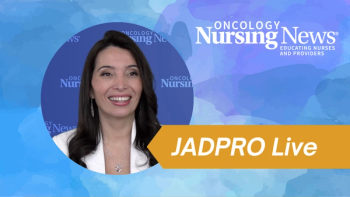
HER2+ Breast Cancer Treatment Continues to Change: Expert Weighs In

The HER2-positive breast cancer treatment paradigm is constantly changing, explained Debu Tripathy, MD, who cited that in less than 1 year, there have been 2 exciting drug approvals, which are tucatinib (Tukysa) and fam-trastuzumab deruxtecan-nxki (Enhertu).
The HER2-positive breast cancer treatment paradigm is constantly changing, explained Debu Tripathy, MD, who cited that in less than 1 year, there have been 2 exciting drug approvals, which are tucatinib (Tukysa) and fam-trastuzumab deruxtecan-nxki (Enhertu).
“There are certain characteristics of trastuzumab deruxtecan that are distinct from ado-trastuzumab emtansine (T-DM1). In the laboratories and preclinical models, trastuzumab deruxtecan is water soluble. When it’s internalized into the tumor cell, it’s slowly released into the microenvironment and can diffuse back out of the cells,” Tripathy explained. “It may even be able to impact neighboring cells, which is very important. I believe that, after progressing on T-DM1 and receiving trastuzumab deruxtecan instead, we may not go back to TDM-1.”
In an interview with Oncology Nursing News' sister publication, OncLive, Tripathy, a professor and chairman of the Department of Breast Medical Oncology in the Division of Cancer Medicine at The University of Texas MD Anderson Cancer Center, discussed some recent therapeutic additions to the HER2-positive breast cancer armamentarium.
OncLive: How would you define the current treatment landscape of HER2-positive breast cancer?
Tripathy: There are certain cancers that are driven by genetic abnormalities that result in protein characteristics, such as the expression of the HER2 receptor, in this case. These characteristics continue to be an important driver, even as the tumor may evolve through different stages of resistance. We have found that every single treatment we use in HER2-positive breast cancer, upon serial progression, is targeting HER2 in one way or another. That still remains a viable target. It's just a matter of targeting it in a different manner.
Two new therapies have [recently] been approved. One is an antibody-drug conjugate (ADC), which targets HER2. The toxic moiety is actually a chemotherapy drug, it’s not specific to HER2. The other one is a kinase inhibitor that specifically inhibits the HER2 kinase domain. In fact, it's the only HER2-specific kinase inhibitor; the others inhibit EGFR. These have yielded significant and notable differences, particularly in refractory/resistant breast cancer. These drugs generated a lot of enthusiasm, and many more are in the pipeline.
Could you compare the safety profiles of trastuzumab deruxtecan and T-DM1?
When looking at the safety issues, there are some concerns about trastuzumab deruxtecan in terms of interstitial lung disease (ILD) and gastrointestinal toxicities. Of course, T-DM1 has its toxicities too; you tend to see neuropathy, liver function abnormalities, and thrombocytopenia. They each have distinct toxicities, but that may also guide treatment paradigms. There are going to be trials that move trastuzumab deruxtecan up into further lines of therapy. There will also be head-to-head comparisons against T-DM1. We should get a better understanding of how these drugs work [with these data].
What is the optimal sequence of therapies for patients with HER2-positive breast cancer?
For patients with unchanged, first-line HER2-positive metastatic breast cancer who are presenting with de novo metastatic disease or have already received adjuvant or neoadjuvant trastuzumab, but it's been more than 1 year, first-line therapy has not changed. It’s typically a taxane, most commonly docetaxel—although others use paclitaxel—with trastuzumab (Herceptin) and pertuzumab (Perjeta). That is still our standard first-line therapy.
Second-line therapy is also relatively standard. We're still using T-DM1 on the basis of the EMILIA and TH3RESA studies that showed superiority over lapatinib (Tykerb) and capecitabine (Xeloda), which were second-line therapies that we have used before. Now, looking forward, second-line therapy may change, with ongoing second-line trials that are assessing alternative therapies beyond T-DM1.
The third-line setting is a little open right now. There are 2 drugs that can be used in that setting, in part, depending on what the patients have received previously. The regimen of tucatinib (Tukysa), trastuzumab, and capecitabine can be used in the third-line setting and so can trastuzumab deruxtecan.
Sequencing is based on a few factors. The first consideration is the level of evidence. For example, tucatinib has a higher level of evidence, which was shown in a phase 3 randomized trial. This demonstrated a survival difference. On the other hand, with trastuzumab deruxtecan, we are still awaiting the phase 3 data. The phase 2 data were notable due to the fact that patients were heavily pretreated. This may be an option to save for later.
The final issue is the toxicity. Even though it's very rare, the problems with ILD can be fatal. Of course, this is something to factor in as well. There is also the presence of central nervous system (CNS) disease, which may pivot you more towards tucatinib because it demonstrated activity in the brain. This makes sense because it’s a small molecule inhibitor and, as well as capecitabine, the CNS [penetration] may be a little higher.
That is how we make clinical judgments in terms of which agents to use in the third-line setting. Of course, whatever you don't use in the third-line setting can be used in the fourth-line setting. It's not uncommon for our patients with advanced HER2-positive disease to do well and to have good performance statuses on later lines of therapy.
Pending the FDA approval for margetuximab, how could this agent be integrated into a patient’s treatment course?
That's hard to say. Margetuximab is a very interesting drug, in theory, due to the way it was designed. The idea of being an engineer to better augment and interact with the immune system is something that has been thought about for a long time. It's been over a decade now that we've recognized that the immune system plays an important role in the response of HER2-positive breast cancers, especially when using antibodies. The antibody that is approved is IgG1, which has the ability to engage T cells and effector cells. Therefore, the binding of the fragment crystallizable (FC) region of the antibody to these effector cells can be variable because people inherent different versions of the receptors. This is engineered in a way that binds the FC region more tightly to immune components. This has been demonstrated in preclinical models.
The main questions are: “How does this translate clinically?” and “What is the human immune system actually seeing and how well is it reacting?” The SOPHIA trial showed that it does seem to be making a difference. The clinical difference is not that great, in terms of progression-free and overall survival but, nonetheless, it’s important. I believe it may have a role in later lines of therapy. Some of the ongoing studies may pinpoint patients who benefit more [from margetuximab] than others. I believe that continuing to refine this whole concept is an important area. There are other bispecific antibodies that engage the immune system that are being tested right now. This whole field is ripe for advances, but I clearly believe there will be a role, and perhaps in later lines of therapy.
What is the rationale for exploring genomically guided therapy in patients with HER2-positive breast cancer who have brain metastases?
I believe that genomically guided therapy can be used for any patient. Whether there's brain metastases or not, “genomically directed therapy” is a broad term. There are many ways you can interpret that one, for example, when you're targeting a specific mutation. One of the more common druggable mutations that we see in HER2-positive breast cancer are PIK3CA mutations. About 25% of HER2-positive cancers do harbor this mutation.
There are ongoing trials combining PI3K inhibitors with trastuzumab or trastuzumab plus pertuzumab. For example, in the maintenance phase after induction therapy, in the first-line setting, there's a large study ongoing with alpelisib (Piqray) and trastuzumab plus pertuzumab. We're going to learn more about genomically targeted therapies.
We know that CDK inhibitors now have shown improvements when combined with HER2- targeted therapy. Therefore, that is another area that is ripe for exploration. I do believe that as we learn more about the genomic landscape of HER2, we will find better drugs. It's clear that under selective pressure, you do get additional mutations. Even the RAS pathway can now exhibit mutations particularly in patients on hormone therapy and have HER2-positive and hormone receptor—positive disease. We will more of these niche trials with rare populations of patients. They will require collaboration on a national and global level for enrollment.
Have there been therapeutic developments specifically for patients with leptomeningeal disease?
Yes; leptomeningeal disease remains a very difficult disease to treat. In HER2-positive disease, there are some interesting trials. There is one currently open through the Translational Breast Cancer Research Consortium, which is one with tucatinib, trastuzumab, and capecitabine, which is essentially the same regimen tested in the HER2CLIMB trial.
There are some data from the large randomized trial on CNS, and even some pilot data on a few patients with leptomeningeal disease. That is an ongoing study. We also have other approved drugs that are specifically for patients with brain metastases, which we sometimes use in leptomeningeal disease. For example, the combination of neratinib (Nerlynx) and capecitabine is one that is active. It’s listed with the National Comprehensive Cancer Network as treatment just for CNS disease, but it can be used for leptomeningeal disease as well.
This article originally appeared on OncLive as, "


















































































